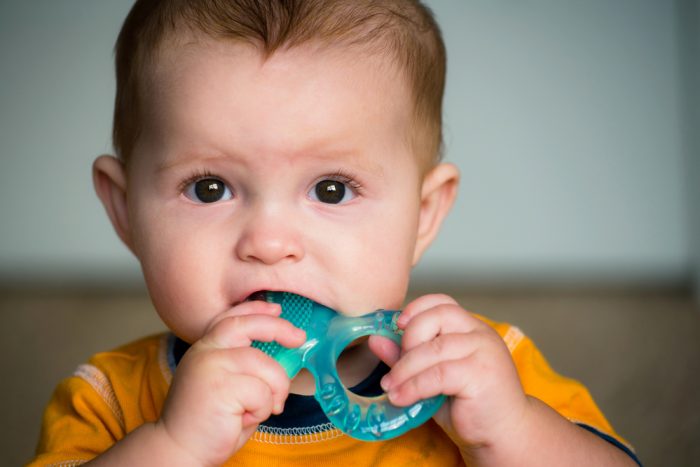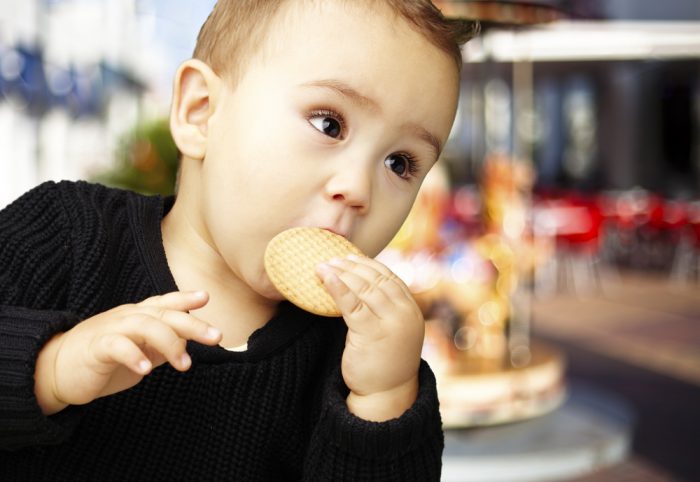
The COMPLETE GUIDE to Baby Teething: What to expect?
- Created:
30. 6. 2020 - Updated:
4. 10. 2023
It is the nightmare every new parent fears. The time when your precious little angel suddenly transforms into a rabid chipmunk. Just when you thought your baby finally started sleeping through the night. Teething is here!
Jump to:
Teething is the process during which your baby’s milk teeth cut through the gums. It is a painful experience for most babies and stressful time for parents. The first tooth to break through is usually the lower incisor and it will probably appear around the 6th month (go to teething chart).
There are some common symptoms that may give you a clue about why your baby is so cranky and fussy (go to teething symptoms). Your baby will be drooling all over the place and biting on anything she can get her hands on.
You also probably have lots of questions regarding your baby’s health and behavior (go to teething FAQ). Luckily there are thousands of tips, advice, and teething toys that can help you get through this period of time (go to teething remedies). For moms, we recommend lots of wine and coffee.
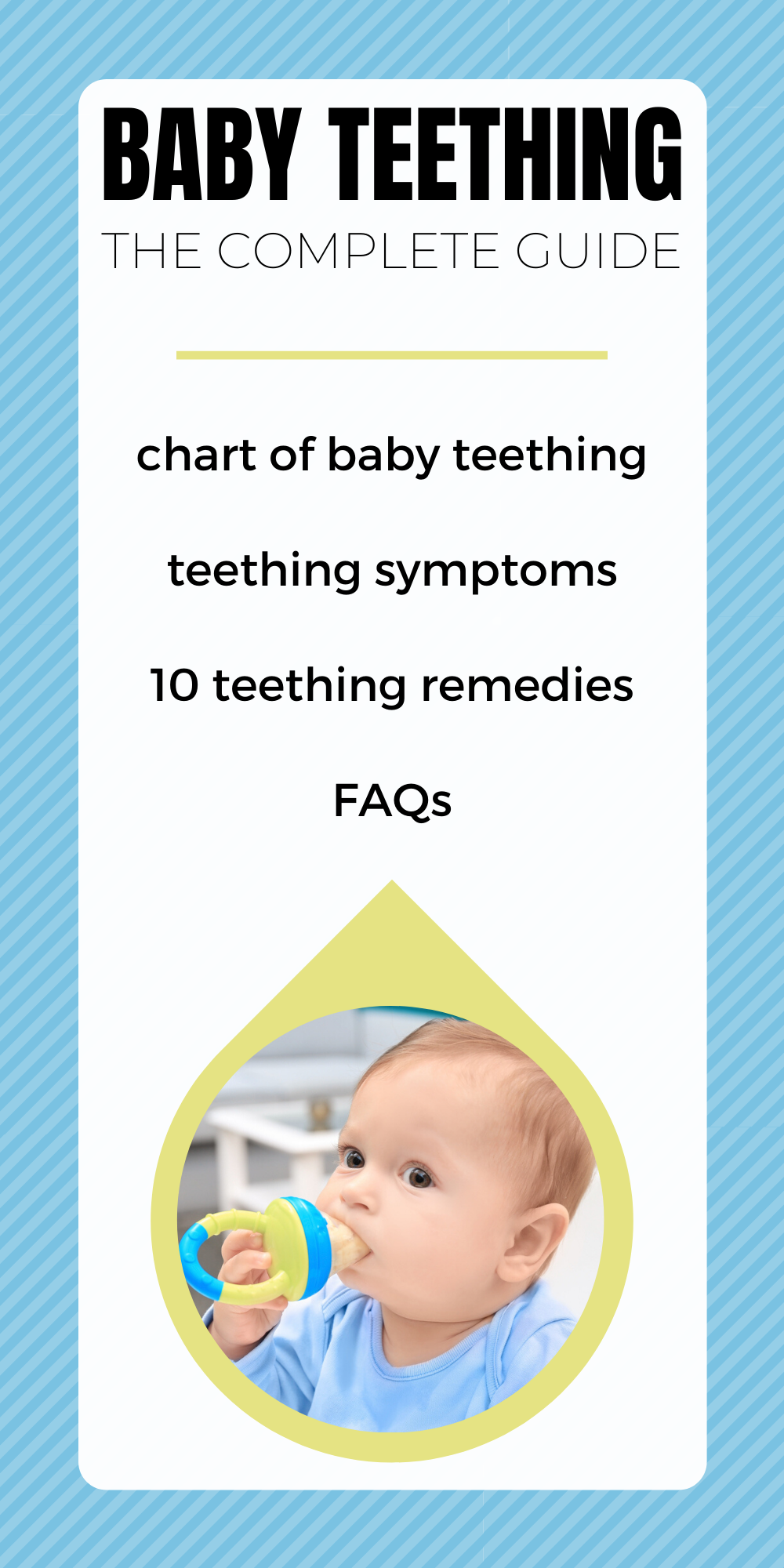
When do babies start teething?
Your baby will probably get his first tooth around the 6th month. However, teething can start as early as 3 months or as late as 10 or even 12 months. So don’t worry if your baby won’t celebrate its half-year with a tooth in his mouth. Just wait or consult your pediatrician if you want to.
The first tooth to cut through the gums is typically the lower incisor followed by the upper incisors about 2 months later. There will be a new tooth appearing approximately every 2 months. Your baby should have a full set of teeth at 2,5 or 3 years of age.
One tooth takes about 1-7 days to cut through. The uncomfortable teething symptoms should only last a couple of days. So consult a pediatrician if your baby seems to experience the symptoms for longer than that.
A chart of baby teething
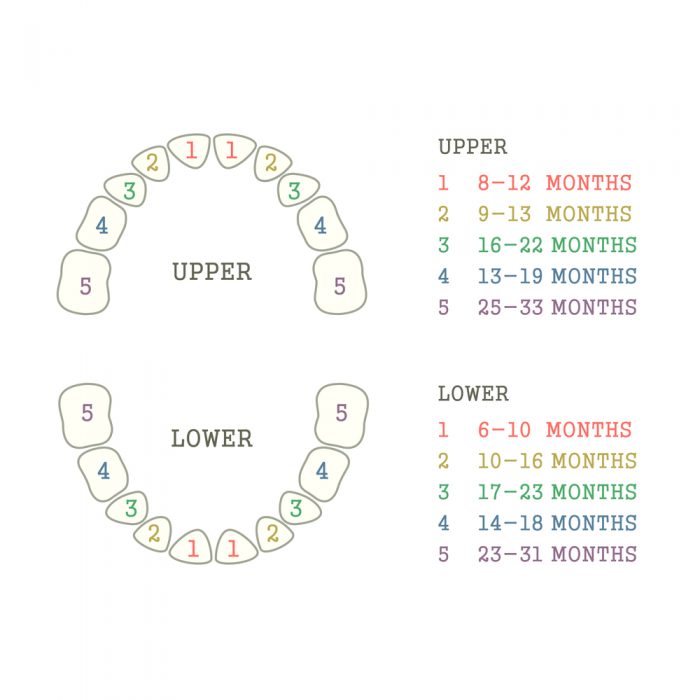
Common teething symptoms for babies
1. Sore and swollen gums
The tooth is putting pressure from beneath the gums and this makes them swollen and reddish.
You can relieve the baby’s pain by massaging the tender gums with your finger or apply something cold (link) to soothe them.
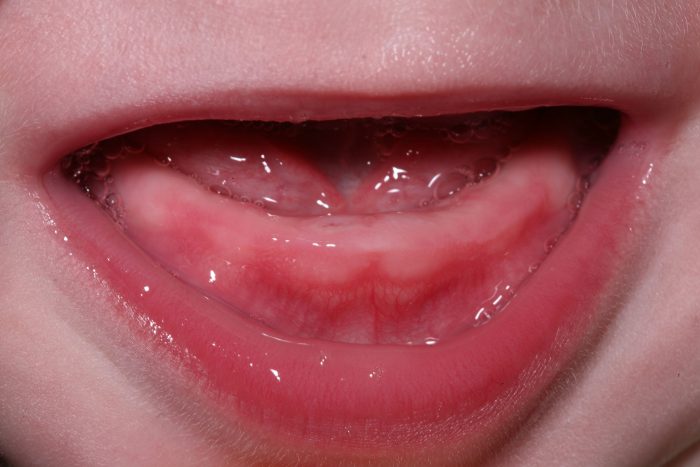
Image source: Wikipedia
2. Chewing on anything and everything
Whatever will your baby gets her hands on (even the hands themselves) she will probably chew on.
This is because it soothes their aching gums by putting pressure on it. Luckily, there are tons of teething toys and other teething remedies (link) that can help. So hopefully they will be biting on other things rather than your breasts (ouch!).
3. A lot of drooling
The amount of drool will increase during teething.
This is because saliva can soothe and lubricate the tender gums. Excessive drooling can cause a rash on the baby’s face (link). Try to keep the area as clean and as dry as possible by patting it with a clean washcloth. You can also use some cream or oil.
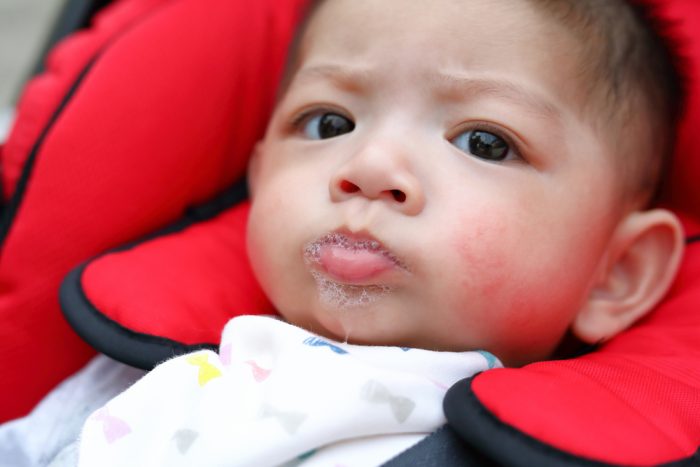
4. Baby is often irritated, cranky or fussy
Your baby will probably cry more.
Teething is unpleasant at best and can be really painful for the baby. They are irritated easily and demand constant attention to distract themselves from the pain. Give them lots of cuddles to help them get through this time period.
5. Refuses to drink or eat
Your baby’s appetite may be lower during teething.
This is because food triggers their sore gums. The best way to approach this is to feed your baby frozen meshed fruit and vegetables (link) or finger food. If your baby is too young for solid foods give her frozen breastmilk (link) or formula.
6. Baby has trouble sleeping
The pain from the tooth prevents babies to sleep well.
With no distractions during the night, your baby feels the pain even more strongly and can wake up frequently. He can even cut down nap times during the day. Good luck and try not to lose your sanity.
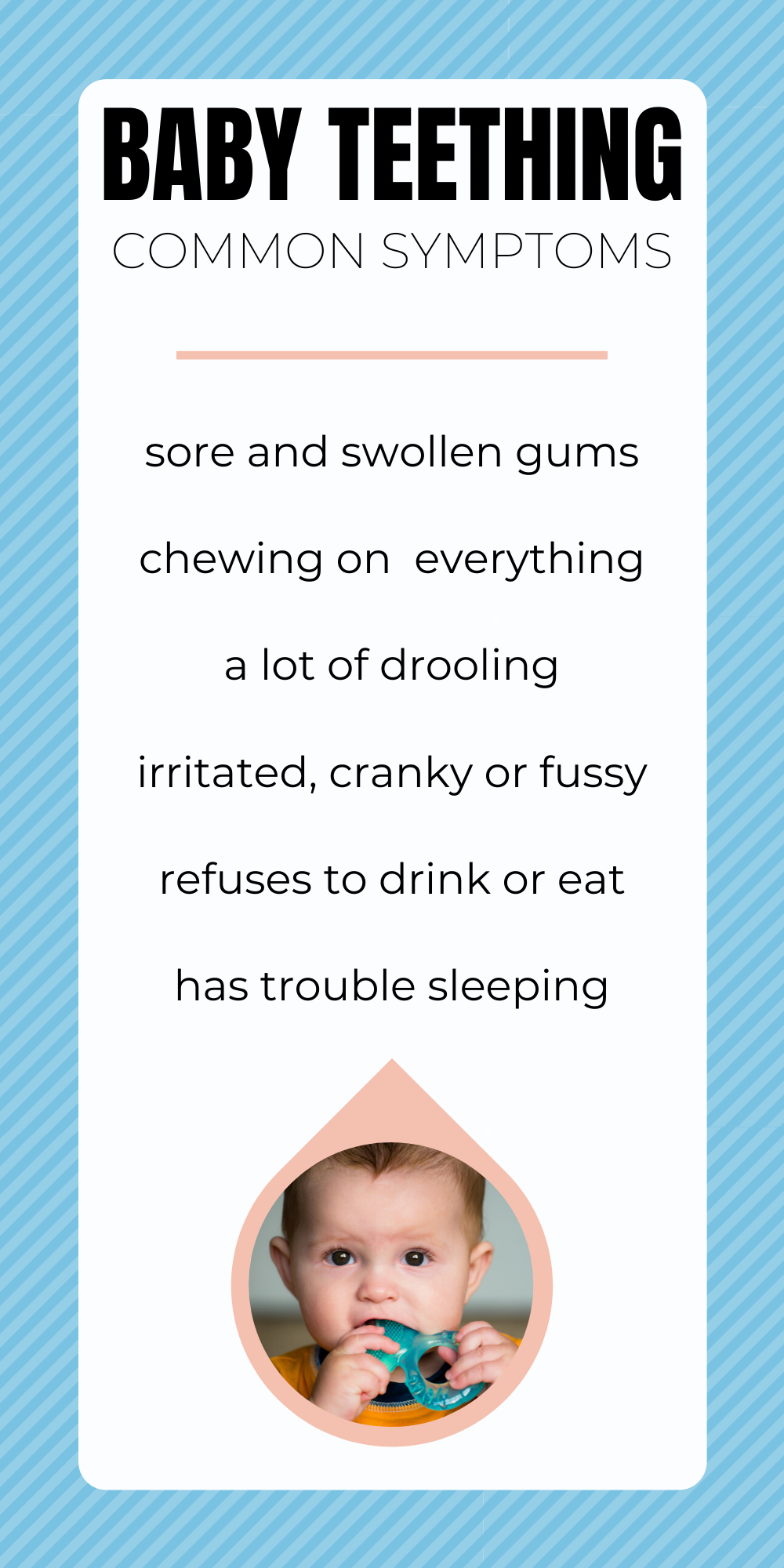
Best baby teething remedies
A) A cold popsicle
Anything cold is very soothing for the baby’s sore and swollen gums. Cold numbs the painful area and reduces inflammation.
Give your baby something cold and clean to bite on. It can be anything from frozen fruit and vegetables to just a chilled metal spoon. One of the best tricks is to fill a feeder with frozen fruit, meshed food or even breastmilk.
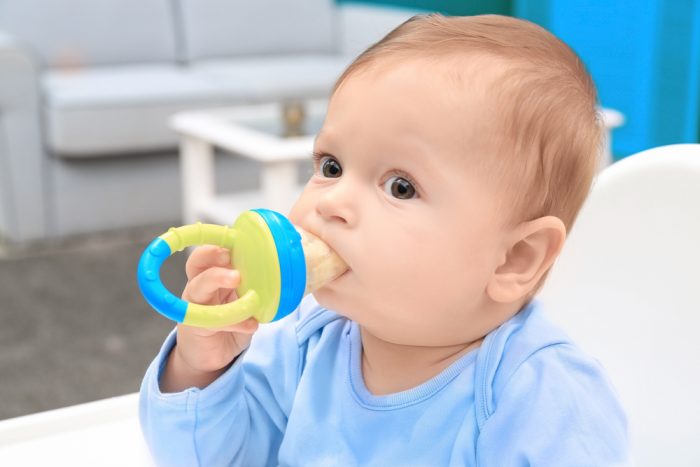
1. Frozen fruit or vegetable
You can kill two birds with one stone with this trick.
Your baby won’t be probably eating much during teething because of the tender gums. This trick will soothe your baby’s gums as well as feed her a bit.
There are two ways you can approach this. Freeze up some cucumber or carrot stick if your baby is old enough for finger food. Otherwise, just mesh some cold fruit into a mesh or silicone feeder.
2. Frozen breastmilk
Frozen breastmilk or formula will work just as well.
This is the ideal solution if your baby is too little for solid food. Freeze some breastmilk or formula in a silicone feeder. The cold will soothe your baby’s gums and feed him a bit at the same time. You can also make breastmilk popsicles by freezing breastmilk in ice cube trays and put a pacifier in it.
3. Frozen pacifier or baby bottle
You can freeze water in the pacifier or the nipple of a feeding bottle to make it extra cold. Your baby will chew on it and that will soothe her swollen gums.
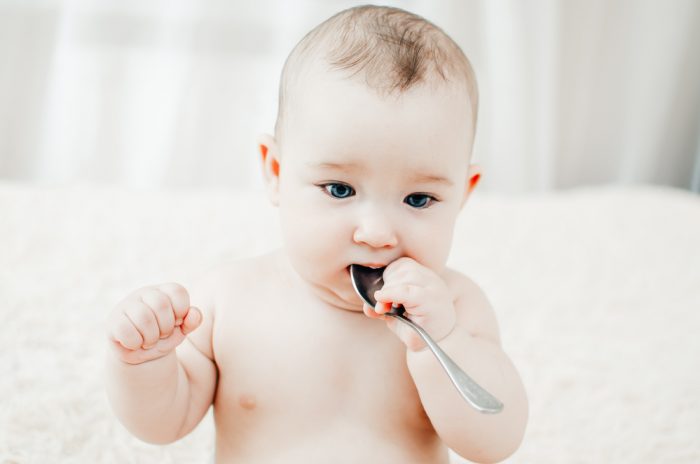
4. Chilled metal spoon
The easiest way to give something cold to your baby is a chilled metal spoon. Put it in the freezer for a couple of hours and give it to your baby to numb the painful gums.
B) Something to bite on
Another way to offer relief to your baby is to just put pressure on the gums. Sometimes just chewing on something semi-hard will help babies to feel better.
You can massage your baby’s gums with your clean fingers but a good teether toy or a teething biscuit can offer a similar relief for the baby’s itchy gums.
It is a great idea to make it cold (put it in the freezer for a couple of hours) as well to numb the painful area.
5. Teether toys
Teether toys are specially made to be chewed on and provide relief during this unpleasant time period.
There are many different toys for you to choose from. Try a couple of them to find out what really suits your baby the best.
6. Chilled washcloth
Sometimes, all you need to help your baby out is a clean washcloth.
Soak it in water and put it in the freezer for an hour. Your baby will have a soft, cold, safe new toy to chew on and soothe her sore, aching gums.
7. Teething biscuits
Your baby can gnaw on these to put pressure on his gums.
These are great to teach your baby how to chew now that he has some teeth. You can make them at home or buy them at the store.
8. Teething mitten
A teething mitten is a special glove that goes on your baby’s hand and has a plastic part for your baby to gnaw on.
The great thing about a teething mitten is that your baby has it on her hand and she can chew on it anytime she wants.
C) A teething necklace
There are 2 types of teething necklaces.
The Baltic amber teething necklace is for babies to wear and it helps to reduce the physical pain they are feeling from teething. The other type of teething necklace is teething jewelry and it is for moms to wear. It is made from wood or silicone and your baby can chew on it while you are holding her in your arms.
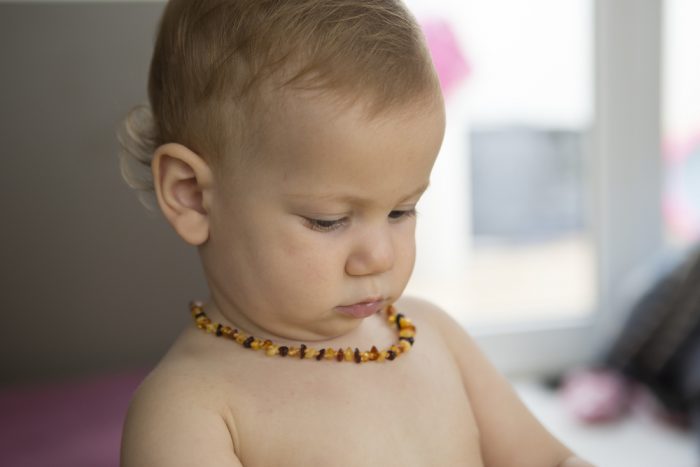
9. Baltic amber teething necklace
This is a necklace for your baby to wear. While wearing it, the necklace releases the succinic acid that helps to relieve pain in the body.
10. Teething necklace for moms
Your little chipmunk can gnaw on this jewelry whenever you are holding her in your arms. A necklace like this is made from wooden or silicone beads.
Final Tip: Soothing Teething Troubles with Annie Baby Monitor
Navigating the ups and downs of baby teething can be challenging.
But you can find relief with the help of Annie Baby Monitor. This app become your secret weapon for monitoring your baby’s comfort during teething.
With Annie Baby Monitor, you can keep an eye on your little one’s reactions and be there for them when they need you during their teething journey. It’s all about making sure they’re comfortable and happy!

Looking for ways to soothe your teething baby? Check out our articles for helpful tips.
Has your little one sprouted their first tooth yet? Don’t forget to track this special moment by using the Annie Baby Tracker. It’s the perfect way to keep track of all those precious milestones!
Don’t miss the chance to provide comfort and reassurance. Get your Annie Baby Monitor and make the teething journey smoother for you and your baby.
More baby teething symptoms (FAQ)
Before you start reading we must stress that not even pediatricians can agree on the answers to these questions. Scientifically speaking, there is just not enough evidence to link these symptoms directly to teething.
The Seattle Children Hospital claims, that symptoms such as teething, runny nose, diarrhea, or diaper rash have no direct link to teething. Even though it may be attributed to the stress accompanying the whole teething process.
However, many moms insist their baby was definitely going through some of these during teething.
So when it comes down to it, it truly can be individual. You should always pay special attention to your baby when any of these symptoms appear and consult with your doctor if you have any doubts.
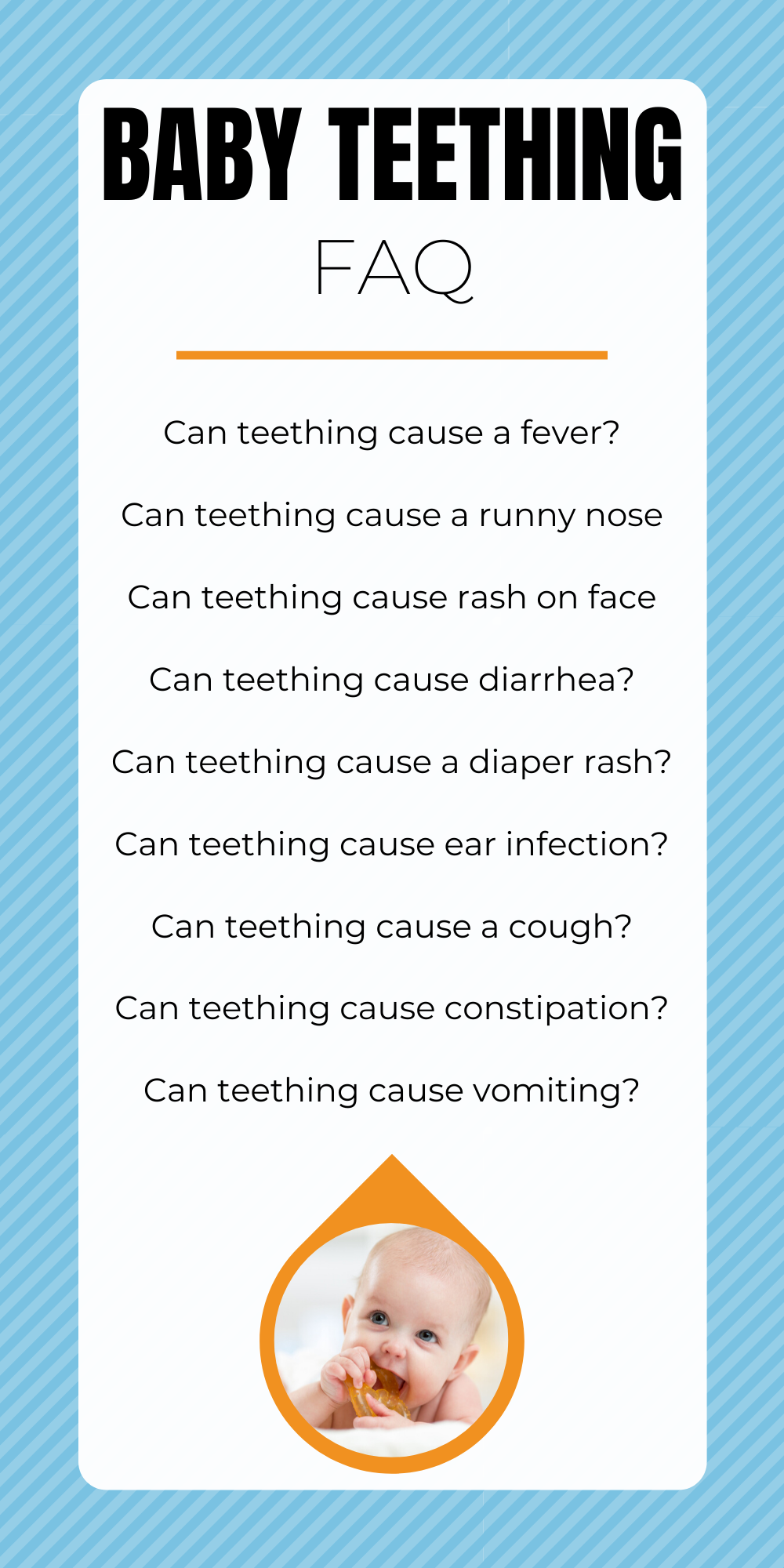
Can teething cause a fever?
A low-grade fever of 100°F (38°C) can be caused by teething. If your baby’s body temperature is higher than that your baby is probably sick and you should consider visiting a doctor. (source)
Can teething cause a runny nose?
The most common reason for a runny nose is cold. During teething, the runny nose can be caused by inflammation around the teeth or from the excessive crying, if your baby is in a lot of pain. (source)
Can teething cause rash on face?
Rash around the mouth can be caused by excessive drooling during teething. Keep the mouth and cheeks dry with a clean cloth to help prevent rashes. You can also apply a cream or coconut oil. (source)
Can teething cause diarrhea?
The supposed link between teething and diarrhea may be caused by 2 reasons. Either by the increased saliva in the system or by chewing on something that wasn’t entirely clean. If the diarrhea is severe or is even accompanied by vomiting and/or fever, be sure to contact your pediatrician. (source)
Can teething cause a diaper rash?
If your baby gets diarrhea it is possible he will also get a mild diaper rash. You should change diapers more often and encourage more diaper-free time. Also, use wipes without fragrance or alcohol to clean your baby bum. (source)
Can teething cause ear infection?
Teething and ear infection are 2 very different unrelated things. However, you may misinterpret one for the other as the symptoms are very similar.
During teething, your baby can be pulling her ears thinking the pain comes from the ears.
If your baby seems to be in pain, has a mild fever, and has no swollen gums or is not drooling chances are it is actually eared infection in which case visit your pediatrician.
(source)
Can teething cause a cough?
Some drool may drip down your baby’s neck causing a teething cough. If the coughing is persistent or your baby doesn’t show other signs of teething, it may be caused by an infection or allergy. (source)
Can teething cause constipation?
Constipation may occur when your baby isn’t eating or drinking as much as usual, causing dehydration. And we already know your baby may refuse to eat or dring during teething due to the pain on the tender gums. (source)
Can teething cause vomiting?
Thedoesn’tsnt seem to be any direct link between vomiting and teething. If your baby is vomiting during teething it is probably beacuse they begin to get exposure to many childhood illnesses. The vomiting is likely caused by a flu or an infection. (source)






















